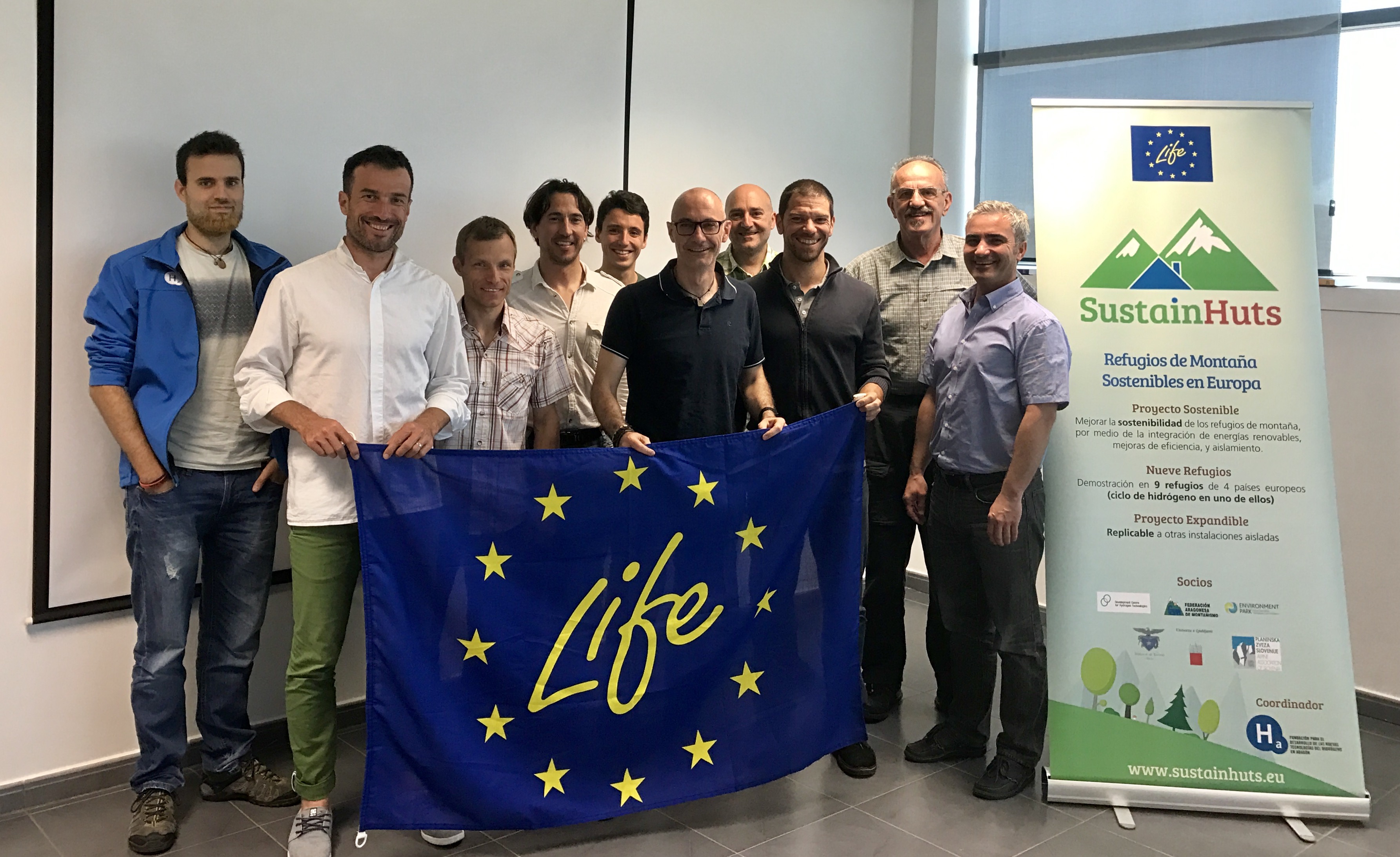SustainHuts achieves its first-year goals
The European project SustainHuts holds its first annual meeting at the facilities of its coordinator, the Foundation for the Development of New Hydrogen Technologies in Aragon.
Last Wednesday, June 7, the Fundación Hidrogeno Aragón hosted the first annual meeting of the LIFE SustainHuts project. A consortium formed by the Aragonese Mountaineering Federation, the Alpine Club Turin section (Italy), Environmental Park (Italy), the Slovenian Mountain Association, the Slovenian Hydrogen Technology Center, the University of Ljubljana (Slovenia).
The SustainHuts project meeting concluded the achievement of the main objectives foreseen for the first year, which allow us to face the following phases with confidence. At present, there is a detailed knowledge of the current state of the shelters under the project, and the studies of the renewable technologies to be implemented are being finalized, as well as the actions aimed at improving the efficiency in the use of energy in the shelters.
Likewise, once the winter is over, access to the shelters is easier and field activities can be resumed. During the next few weeks we will return to Bachimaña, Estós and La Renclusa huts to finalize the installation of the consumption measurement equipment, and in the case of Lizara and Llauset we will return to collect and analyze the information from the equipment installed last year. As for the two Slovenian refuges (Pogacnikov and Kocbekov), activities will also be resumed after the closure during the winter months (they are closed almost 10 months a year). On the other hand, the Rifugio di Torino, although open all year round, due to its high altitude (3300 m) still has half a meter of snow on its roof at this time of year, so the Italian members still have to wait a while to be able to carry out the planned activities.
But it is not all positive news for the project. One of the partners, the Romanians from the University of Brasovia, have announced their official departure from the project. This decision is a consequence of the enormous difficulties that the Romanian partners have encountered, in terms of permits, to be able to implement the technologies planned for their Doftana Valley refuge, which in their case was a micro-hydro turbine. During the annual meeting this issue was discussed in the consortium and several alternatives are being studied, including the integration of a new partner from a non-represented country or that one of the partners incorporates a new shelter with similar characteristics to the Romanian shelter leaving the project.
To modernize from the energy point of view eight mountain refuges in three countries is the main objective of the European project SUSTAINHUTS (Sustainable Refuges) that will be coordinated during the next four years by the Foundation for the Development of New Hydrogen Technologies in Aragon, based in the Walqa Technology Park in Huesca. It is financed by the European Union under the LIFE+ program (LIFE15 CCA/ES/000058) and has a budget of 1,860,914 euros, of which the Union contributes 60%.
The aforementioned modernization of the shelters refers to the installation of technologies based on renewable energies, including in one of them the incorporation of a complete system for the production, storage and use of renewable hydrogen.
The eight mountain refuges are located in Spain (5), Slovenia (2) and Italy (1). The Spanish ones belong to the Aragonese Mountaineering Federation (FAM) and are those of Lizara (1,540 meters altitude), Bachimaña (2,200 m.), Estós (1,890 m.), La Renclusa (2,140 m.) and the recently inaugurated Cap de Llauset (2,450 m.). To these are added the Italian Rifugio di Torino (the highest of all those in the project, at 3,375 m), two Slovenian ones (Pogačnikov dom, at 2,050 m, and Kocbekov dom, at 1,808 m).
In all of them, actions aimed at improving energy efficiency by 20%, reducing CO₂ (carbon dioxide) pollutant emissions by 21 tons per year per shelter and NOx (nitrogen oxide) emissions by 0.5 tons per year per shelter, as well as reducing the number of helicopter trips made to them with the current fuel supply, with an estimated saving of one ton per year of kerosene per facility, will be carried out.
During the first phase of the project, the situation at each shelter and its energy consumption will be evaluated so that a detailed study of the improvement needs can be made. The technologies to be implemented are photovoltaic, mini-hydro, mini-wind, insulating materials, and hydrogen. Subsequently, the technical projects will be prepared, and then the equipment will be purchased and installed. The fourth year will see the demonstration of all these technologies already installed in the shelters.
One of the relevant objectives of the project is to prepare a series of methodological guides that will allow replication of the solutions developed in the shelters, so that the environmental improvements achieved can be taken to other locations both in Europe and around the world.



